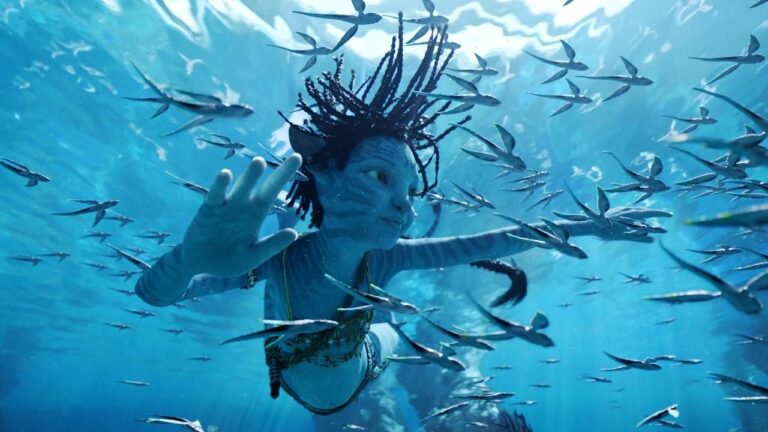James Cameron’s Avatar: The Way of Water has set new records for technological advancements in filmmaking, resulting in a staggering number of unique versions needed for theatrical release.
The film is a sequel to Avatar (2009), the highest-grossing film of all time, and stars Sam Worthington, Zoe Saldaña, Sigourney Weaver, and Stephen Lang.
Despite the lengthy production period of over ten years, it has exceeded expectations and secured its place as the third highest-grossing film ever.
According to The Hollywood Reporter, the success of Avatar: The Way of Water at the box office is mainly due to the crew producing 1,065 versions of the film to be distributed to different theaters.
Variations in audio formats, subtitles, and dubs account for some differences. But the majority are a result of utilizing the film’s advanced presentation technologies such as 4K, HDR, and high frame rates for action sequences in both 2D and 3D.

In recent years, many directors have been exploring the film technique of high frame rate. Notable examples include Peter Jackson’s Hobbit trilogy and Ang Lee’s films Gemini Man, and Billy Lynn’s Long Halftime Walk.
Generally, films are shot and projected at 24 frames per second, closely resembling how the human eye processes information.
However, a high frame rate involves more frames per second, up to 48 frames, in the case of Avatar: The Way of Water. This technique stimulates a hyperreal environment and provides an immersive experience for the audience.
The latest format has garnered mixed reactions from the audience, with some expressing their enthusiasm to explore new possibilities while others being less impressed with the result.
Several viewers have complained about experiencing headaches, dizziness, or disorientation when watching films in this format. Some have also criticized it for exposing the artificiality of fantasy environments and highlighting the inadequacies of make-up, wigs, and special effects.
According to reports, criticism towards high frame rate presentations has been predominantly directed towards past releases such as The Hobbit: An Unexpected Journey.
In contrast, Avatar: The Way of Water has faced less backlash for its selective use of this technique.
This development may not necessarily signify the dawn of a new era for high frame rates, but it suggests that Cameron’s strategy of applying it only to specific scenes could become the norm for certain movies in the industry.
About Avatar: The Way of Water
Avatar: The Way of Water is an upcoming American epic science fiction film directed by James Cameron and produced by 20th Century Studios. It is the second film in Cameron’s Avatar franchise, following Avatar (2009).
Cameron produces with Jon Landau. Cast members Sam Worthington, Zoe Saldana, Stephen Lang, Giovanni Ribisi, Joel David Moore, Dileep Rao, CCH Pounder, and Matt Gerald are all reprising their roles from the original film, with Sigourney Weaver returning in a different role. New cast members include Kate Winslet, Cliff Curtis, Edie Falco, Brendan Cowell, Michelle Yeoh, Jemaine Clement, Oona Chaplin, Vin Diesel, and CJ Jones.
Avatar 2 revolves around a universal concept of family and follows Jake Sully and Neytiri 14 years after the first film as they focus on protecting their child. However, they are forced to leave their home and explore the different regions of Pandora when an old threat returns to finish what they started. Jake has never faced a bigger challenge.


No Comments on Avatar 2 Released 1,065 Unique Versions for Theatres, Setting New Record